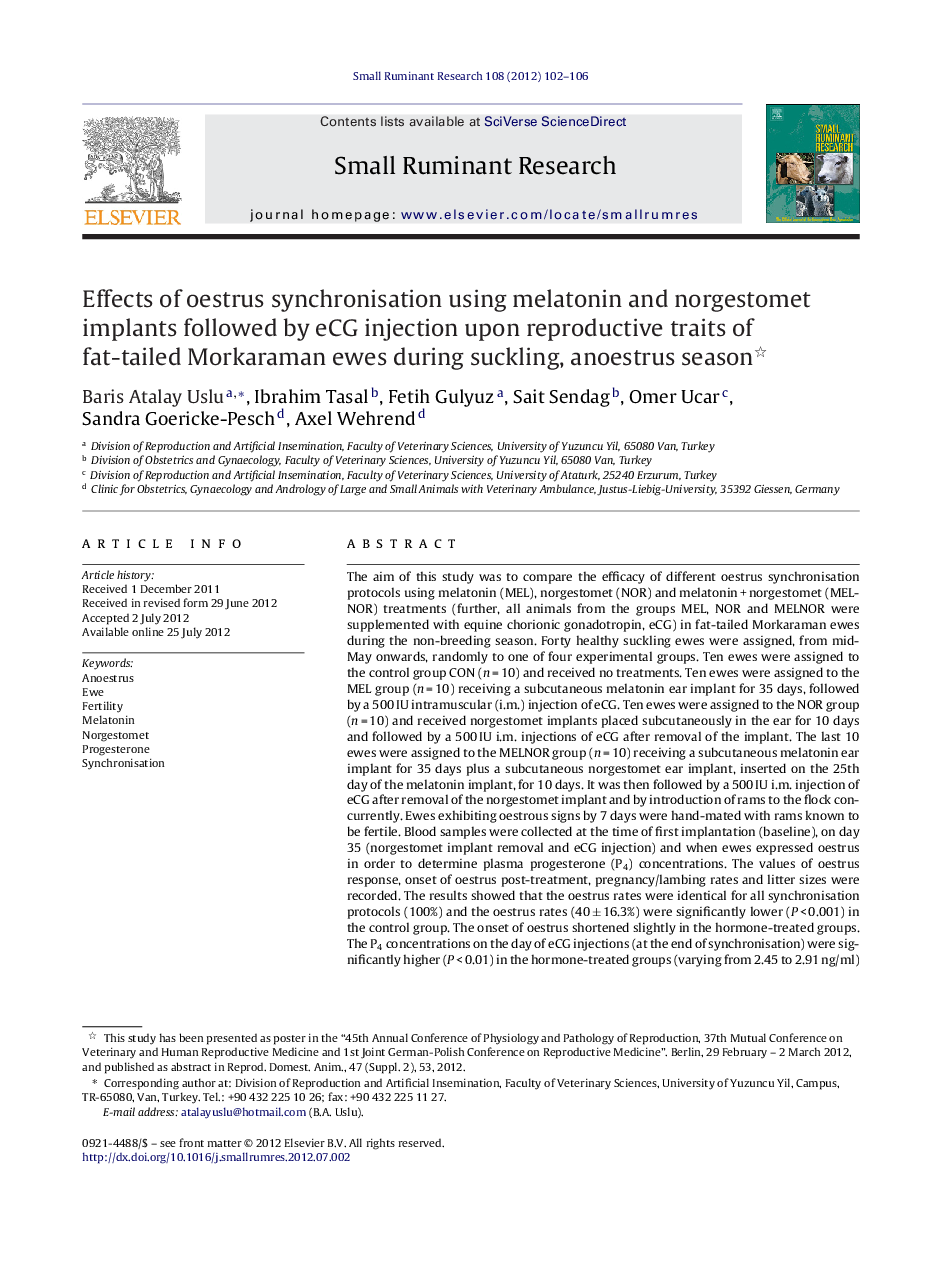| کد مقاله | کد نشریه | سال انتشار | مقاله انگلیسی | نسخه تمام متن |
|---|---|---|---|---|
| 5796240 | 1554384 | 2012 | 5 صفحه PDF | دانلود رایگان |

The aim of this study was to compare the efficacy of different oestrus synchronisation protocols using melatonin (MEL), norgestomet (NOR) and melatonin + norgestomet (MELNOR) treatments (further, all animals from the groups MEL, NOR and MELNOR were supplemented with equine chorionic gonadotropin, eCG) in fat-tailed Morkaraman ewes during the non-breeding season. Forty healthy suckling ewes were assigned, from mid-May onwards, randomly to one of four experimental groups. Ten ewes were assigned to the control group CON (n = 10) and received no treatments. Ten ewes were assigned to the MEL group (n = 10) receiving a subcutaneous melatonin ear implant for 35 days, followed by a 500 IU intramuscular (i.m.) injection of eCG. Ten ewes were assigned to the NOR group (n = 10) and received norgestomet implants placed subcutaneously in the ear for 10 days and followed by a 500 IU i.m. injections of eCG after removal of the implant. The last 10 ewes were assigned to the MELNOR group (n = 10) receiving a subcutaneous melatonin ear implant for 35 days plus a subcutaneous norgestomet ear implant, inserted on the 25th day of the melatonin implant, for 10 days. It was then followed by a 500 IU i.m. injection of eCG after removal of the norgestomet implant and by introduction of rams to the flock concurrently. Ewes exhibiting oestrous signs by 7 days were hand-mated with rams known to be fertile. Blood samples were collected at the time of first implantation (baseline), on day 35 (norgestomet implant removal and eCG injection) and when ewes expressed oestrus in order to determine plasma progesterone (P4) concentrations. The values of oestrus response, onset of oestrus post-treatment, pregnancy/lambing rates and litter sizes were recorded. The results showed that the oestrus rates were identical for all synchronisation protocols (100%) and the oestrus rates (40 ± 16.3%) were significantly lower (P < 0.001) in the control group. The onset of oestrus shortened slightly in the hormone-treated groups. The P4 concentrations on the day of eCG injections (at the end of synchronisation) were significantly higher (P < 0.01) in the hormone-treated groups (varying from 2.45 to 2.91 ng/ml) compared to the control group (0.45 ng/ml). Pregnancy/lambing rates were slightly higher in the synchronised groups (varied from 60 to 80%), compared to the control group. The results of oestrus synchronisation with melatonin and norgestomet ear implants (supplemented with the eCG) showed that: (i) an oestrus onset could be shortened significantly (P < 0.001) with melatonin and/or norgestomet, and (ii) significantly higher (P > 0.01) P4 concentrations and higher lambing rates could be obtained in all hormone-treated ewes when compared to the un-treated Morkaraman ewes during the suckling (anoestrus) season.
Journal: Small Ruminant Research - Volume 108, Issues 1â3, November 2012, Pages 102-106